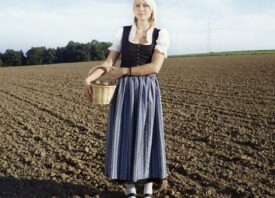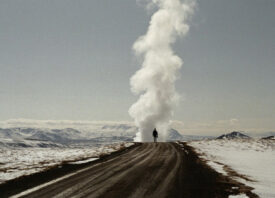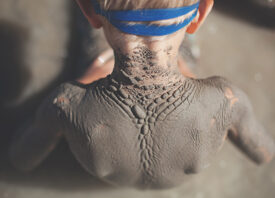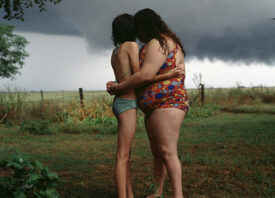Search this site
Magical Photos of Childhood Summers in a Small Austrian Village

Alena plays with a cat and a cow. Merkenbrechts, August 2013

Victor is enjoying his mother’s legs. Merkenbrechts, July 2018
In her project I am Waldviertel, Dutch photographer Carla Kogelman travels to the Austrian region of Waldviertel to the small village of Merkenbrechts, population less than 200. Here, Kogelman transports us into an eternal moment of fleeting childhood summers, a moment where time eclipses in that it is both fast with outdoor adventure, and slow with restless boredom—imagination and play often being its only respite.
Recently published by Schilt Publishing, Kogelman’s series intimately captures the family of Sonja and Roman, and more specifically, their daughters Alena and Hannah, over a period of six summers, returning each year to the family’s horse farm. Immediately bonding with the family and the two girls, it didn’t take long for the photographer to be invited to stay with them on the farm, allowing the series of portraits to become nothing short of familial. Each photograph captures a level of comfort and unguarded trust that is usually reserved for kin. Kogelman explains,
“Halfway through the summer 2012, I met Sonja (the mother), Hannah, and Alena in front of a pond in Merkenbrechts. They invited me to their house and their hearts. We became friends and soul mates. The next time I came along, they even offered me a bed and food. So I was closer to my subjects, which made it even easier and more fun to be there… I show them a lot of the work I am doing, so they knew what I was doing and what my focus was. I include them in what I am doing. I could not do it without them.”
The photographs in I am Waldviertel can be discussed in the same breath of Sally Mann’s photographs in Immediate Family, originally published in 1992, which portrayed her children on her own farm. But while Sally Mann’s photographs capture fierce independence and freedom as well as quiet, hauntingly beautiful scenes, Kogelman’s subjects are squirming with energy; an endless desire for discovery and adventure, causing her subjects to often be in mid-motion, sparking and cracking like a gunshot, ready for action, especially during the first couple of summers, starting in 2012.
During the early years, the children are running, wrestling, twisting their bodies in sometimes awkward positions, leaving the photograph candid and unrestrained. Spending all of the summer on the horse farm, Hannah and Alena create their own amusement swimming in creeks, playing with animals, and simply finding interesting aspects of nature to pass the time. The children are at times laughing uncontrollably, engulfed in a game, and at other times slumped on the couch, staring absentmindedly perhaps out of tiredness or dullness. This is what childhood is often like—timeless, but over in a flash, just like summer.
With many of the children being under fourteen, this is an age when we have less inhibition—before the pain of puberty. Kogelman beautifully captures this freedom—the kind you find in summer, adventure, and play. It is the same kind of freedom you find in the intimacy of childhood friendship and siblinghood—with no restraints. The sincerity in Kogelman’s portraits reveals to us the joys that occur without these limitations.
However, unlike the sweet, dewy memories of timeless summers, things go on. The children do not stay in this perpetual state of imagination. They get older, and interests change. Although Alena and Hanna are still on the farm, making their own entertainment with their siblings and other children in the village, we start to notice things shifting. In 2016 and 2017, there are moments of the sisters wearing high-heels, curling their eyelashes. Later, we see a glow of a screen and a phone or two. Time goes on. There is a wedding. The sisters are growing up. Coming back for a couple weeks every summer, Kogelman, too, notices these changes upon her return:
“Every first day I notice the difference with the previous year, but soon it is like I have not been away … And in fact every year my camera falls in love again and they feel at ease.”
Within the sea of black and white faces, there are two that sit next to each other so perfectly and vividly: a photograph of what appears to be at least three generations of the family, the frame of the composition filled edge to edge with people, and a rare photograph containing no people, but instead a quiet field of sunflowers. Together, we see the timelessness of family itself, going on after we ourselves are gone; a field of sunflowers growing together. In her breathtaking sequence of photographs in I am Waldviertel, Kogelman creates an incredible wave of nostalgia that sweeps over the body in one powerful gust, pulling the viewer into an experience of memory, life, and love. Find the book here.

Hannah and Alena are watching over the fields. Merkenbrechts, July 2012

Hannah and Alena are taking a swim in the pond in front of their house. Merkenbrechts, July 2012

Alena on a swing. Merkenbrechts, August 2012

A horse at the Wegwarterhof dresses up. Merkenbrechts, July 2018

Hannah is walking along a fence. Waiden, August 2016

All images © Carla Kogelman, courtesy Schilt Publishing



